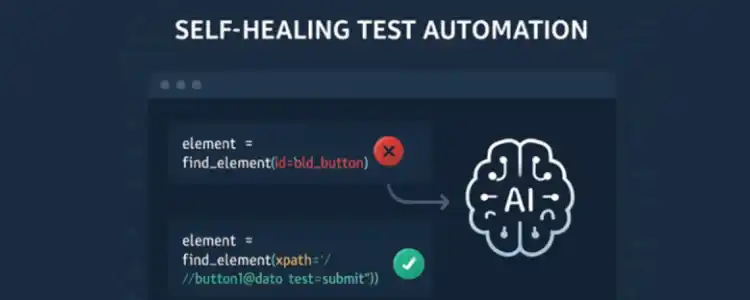
In today’s dynamic software landscape, applications are updated and enhanced at a breakneck pace. While this fuels innovation, it also introduces a critical challenge: automated tests breaking with every UI change or feature update. If you’re seeking a smarter, future-proof approach to test automation, you’re in the right place. This comprehensive guide will walk you through everything you need to know about self-healing test automation—from fundamentals to implementation—so you can build robust, adaptive test suites that keep up with your business.
What is Self-Healing Test Automation?
Self-healing test automation is an advanced approach in which your automated tests can intelligently detect changes in the application under test and automatically update themselves—no manual intervention required. Instead of failing when a button is renamed or a field is moved, self-healing frameworks use AI and machine learning to find alternative ways to identify elements and keep your tests running smoothly.
In simple terms:
Self-healing test automation means your test scripts can “heal” themselves when something changes, ensuring uninterrupted execution and dramatically reducing maintenance effort.
Why Invest in Self-Healing Test Automation?
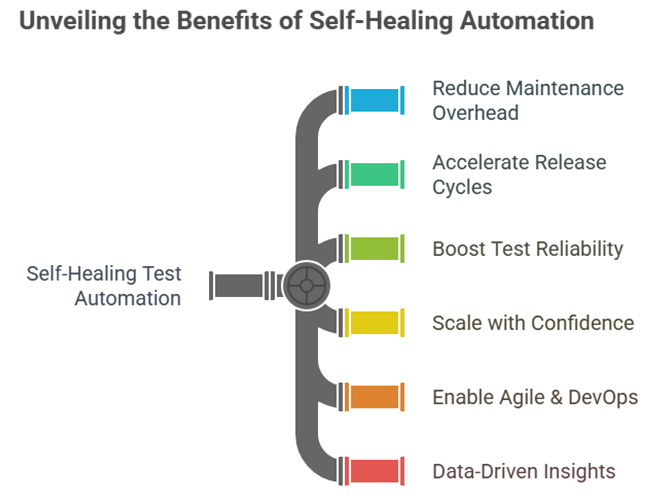
- Reduce Maintenance Overhead: Teams report up to 85% reduction in test maintenance effort when switching to self-healing automation.
- Accelerate Release Cycles: Less time fixing tests means faster, more reliable releases.
- Boost Test Reliability: Fewer false failures, more trust in your automation.
- Scale with Confidence: Focus on expanding test coverage, not fixing broken scripts.
- Enable Agile & DevOps: Perfect fit for fast-moving teams needing robust, adaptive automation.
- Data-Driven Insights: Get actionable analytics on what’s breaking and how your tests are adapting.
Key Features of a Successful Self-Healing Test Automation Framework
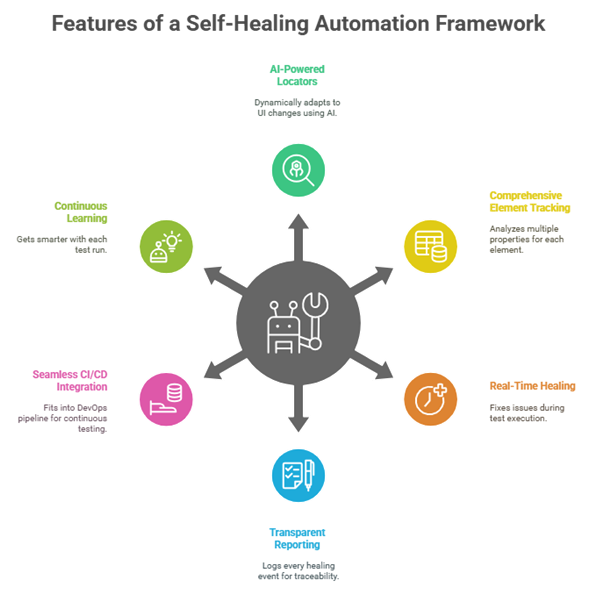
To stand out in the competitive automation landscape, your self-healing solution should include these essential features:
- Continuous Learning: Gets smarter with every test run.
- AI-Powered Locators: Dynamically adapts to UI changes using multiple attributes and context.
- Comprehensive Element Tracking: Remembers and analyzes multiple properties for each
- Real-Time Healing: Fixes issues during test execution, not after.element.
- Transparent Reporting: Logs every healing event for full traceability.
- Seamless CI/CD Integration: Fits right into your DevOps pipeline for continuous testing.
Steps to Implement Self-Healing Test Automation
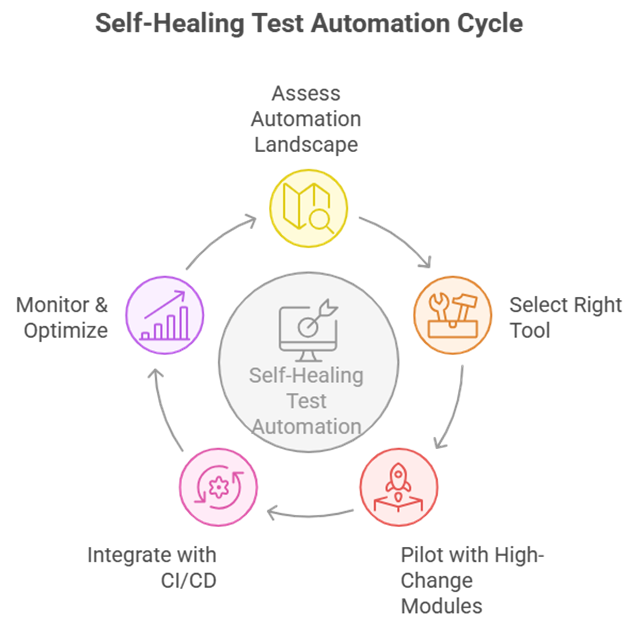
Assess Your Automation Landscape:
Identify areas with frequent UI changes or high maintenance overhead.
Select the Right Tool:
Choose a self-healing framework like ideyaLabs’ iTAF that fits your technology stack and business needs.
Pilot with High-Change Modules:
Start with applications or modules that are updated often.
Integrate with CI/CD:
Ensure your self-healing tests run automatically in your build and deployment pipelines.
Monitor & Optimize:
Review healing reports, validate changes, and fine-tune your strategy for continuous improvement.
How Does Self-Healing Test Automation Work?
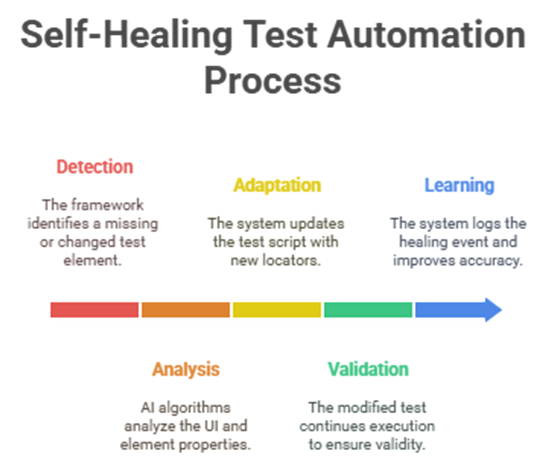
Self-healing test automation platforms—like those offered by ideyaLabs—use a combination of AI, machine learning, and smart algorithms to monitor test executions. Here’s how the process unfolds:
1. Detection:
The framework detects that a test element (like a button or field) is missing or has changed.
2. Analysis:
AI algorithms analyze the application’s UI and element properties, searching for alternative locators (XPath, CSS, text, etc.).
3. Adaptation:
The system intelligently updates the test script in real-time, replacing outdated locators with new ones.
4. Validation:
The modified test continues execution, ensuring the change is correct and the test remains valid.
5. Learning:
Each healing event is logged, and the system learns from past fixes, improving its accuracy over time.
Real-World Impact: Success Stories
E-commerce Platform
Challenge: Frequent UI updates broke regression tests.
Solution: ideyaLabs implemented self-healing automation.
Outcome: 70% drop in test maintenance, 50% faster releases, 99.9% uptime during peak events.
Healthcare Provider
Challenge: Compliance and data accuracy across frequent portal updates.
Solution: Self-healing automation handled UI and workflow changes.
Outcome: 80% reduction in manual test fixes, 99.9% data validation accuracy, HIPAA compliance maintained.
Financial Services
Challenge: High cost of maintaining tests for complex, regulated apps.
Solution: Self-healing test automation by ideyaLabs.
Outcome: 420% ROI in 18 months, compliance coverage increased from 60% to 95%, faster audit cycles.
Best Practices for Self-Healing Test Automation
- Start with High-Change Areas: Focus on modules with frequent UI updates.
- Monitor and Review: Use healing reports to validate changes and continuously improve.
- Integrate with DevOps: Make self-healing part of your CI/CD for maximum agility.
- Educate Your Team: Ensure everyone understands how healing works and how to leverage it.
The Future of Test Automation
As applications become more dynamic and user experiences more complex, self-healing test automation is set to become the industry standard. With AI-driven adaptability, organizations can move beyond maintenance headaches and focus on delivering innovation.
Emerging Trends:
- Predictive Healing: AI anticipates changes before they break tests.
- Cross-Platform Healing: Works for web, mobile, and APIs.
- Advanced Analytics: Insights into healing patterns for smarter test strategies.
FAQS
What is self-healing test automation?
Self-healing test automation is an AI-powered approach where automated tests detect changes in the application and automatically update scripts to prevent failures.
Why is self-healing test automation important?
Self-healing test automation reduces manual maintenance, minimizes test failures, and ensures stable test execution even when the application changes.
How does self-healing test automation work?
Self-healing test automation uses multiple locators and AI algorithms to find and fix broken elements in test scripts, updating them in real-time during execution.
What are the benefits of self-healing test automation?
Key benefits include lower maintenance effort, improved test reliability, faster release cycles, and better test coverage.
Can self-healing test automation integrate with existing frameworks?
Most self-healing solutions work with popular automation frameworks and CI/CD pipelines for seamless adoption.
Conclusion
Self-healing test automation is transforming how organizations approach quality assurance. By minimizing maintenance, boosting reliability, and enabling true continuous testing, it empowers teams to deliver better software, faster. At ideyaLabs, we help businesses harness the power of self-healing automation to stay ahead in a competitive digital landscape.
Ready to future-proof your QA strategy?
Connect with ideyaLabs to discover how self-healing test automation can revolutionize your testing process.